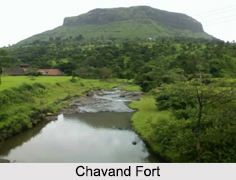 The forts in Pune district in the state of Maharashtra, have been the centres of a number of rulers and stand gracefully as witnesses of significant historical events. Most of these forts are located over the hills amid picturesque natural beauty. The structure of the fort flaunts the brilliant architecture prevailing in the bygone eras. From defence as well as artistic point of view, the forts have an impressive structure. Some of the forts have been well preserved by the Archaeological Survey of India while many have ruined owing to various battles and time. These ancient forts in Pune district are the monuments of national importance and form exquisite tourist and trekking spots.
The forts in Pune district in the state of Maharashtra, have been the centres of a number of rulers and stand gracefully as witnesses of significant historical events. Most of these forts are located over the hills amid picturesque natural beauty. The structure of the fort flaunts the brilliant architecture prevailing in the bygone eras. From defence as well as artistic point of view, the forts have an impressive structure. Some of the forts have been well preserved by the Archaeological Survey of India while many have ruined owing to various battles and time. These ancient forts in Pune district are the monuments of national importance and form exquisite tourist and trekking spots.
Chavand Fort
Chavand fort is an ancient fort located over Sahyadri mountain range near the town of Naryangoan in Pune district. Rising to a height of 1,036 m above sea level, it is one of the forts of `famous 5 trek`, the other four being Naneghat, Jivdhan, Shivneri and Hadsar. The fort was however looted and demolished by the British. The ruins of the fort suggest that it was constructed about 800 years ago.
Korigad Fort
Korigad fort is another fort situated at a distance of 20 km from Lonavla in Pune district. The exact date of its construction could not be deciphered. In 1657 the fort was annexed by Shivaji. Although the interiors of the fort has ruined over time, its outer wall is completely intact with a massive gate in it. The fort has 6 canons and a Korai devi temple.
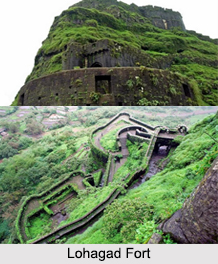 Lohagad Fort
Lohagad Fort
Lohagad fort is another hill fort which belonged to Shivaji. It is located at a distance of 52 kilometres from Pune and divides the basins of Pavna and Indrayani. It has 4 huge gates which have still retained their intact condition. According to the historical records, constructional features were added in the fort during the later Peshwa period. The fort offers a splendid view of the Pawna dam.
Narayangad Fort
Narayangad fort is a hill fort situated near the city of Pune and is presently in ruins. It belongs to Satvahan era and served as a watch point for the Junnar Paithan route. At its highest point, the fort houses a temple of the Goddess Hastamata. The first renovation of the fort is said to have been carried out by the first Peshwa Balaji Vishwanath and was given in service-grant to Sayaji Povar. The fort was surrendered to the British in the last Maratha war of 1818.
Sangram Durg
Sangram Durg is another ancient fort located at Chakan, Pune. In 1660 the fort was defended by renowned Maratha warrior and military leader of the troop of Shivaji named Firangoji Narsala against the army of Mughal led by Shaista Khan. For his brave endeavour he was rewarded by Shivaji by making him the Killedar of the Bhupalgad fort.
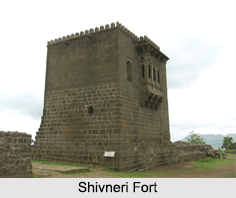 Shivneri Fort
Shivneri Fort
Shivneri fort is a military fortification situated near Junnar. Built in 17th century it is the birthplace of Chhatrapati Shivaji who was the founder of Maratha Empire. The fort houses statues of Jijabai and young Shivaji. A water pond known as Badami Talav is situated at the centre of the fort. Two water springs can also be found inside the fort, namely Ganges and Yamuna, which have water all round the year.
Sinhagad Fort
Sinhagad fort is another famous fort of Pune district situated at a distance of 30 kilometres from the city of Pune. The fort has witnessed a number of significant historic battles, prominently the battle of Sinhagad in 1670. It stands on a lone cliff of the Bhuleswar range of the Sahyadri Mountains, naturally protected by steep slopes.
Tikona Fort
Tikona fort is another hill fort located in Maval, near kamshet, in Pune. It is a popular trekking destination owing to its large gates, some Satvahan caves, a water tank and some other intriguing features. Near the fort, a beautiful lake can also be visited.
Torna Fort
Torna fort, also known as Prachandagad, is famed for being the first fort conquered by Shivaji in the year 1643. He captured the fort at the age of 16 years and marked the foundation of Maratha Empire. It is the highest hill fort in the district which rises to a height of 1,403 metres. It was built in 13th century by the followers of the Hindu God Shiva, the Shaiva Panth.
Tung Fort
Tung fort is another hill fort situated near Lonavla. It is also called as Kathingad fort and the route to reach the fort is quite difficult. The conical fort is reached through steep climb. It was constructed by Adil Shahi dynasty before 1600 CE and was later conquered by Shivaji. Its architecture suggests that it mainly served the purpose of a watchtower guarding the road to Pune city.
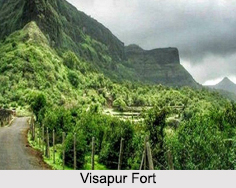 Visapur Fort
Visapur Fort
Visapur fort stands on the same plateau as Lohagad, in the district of Pune. It was structured by the first Peshwa of Maratha Empire, Balaji Vishwanath, during 1713-1720 CE. The outer wall has still retained its intact condition. The fort is much larger than Lohagad and owing to its high elevation it was used by the British troops to set up their canons for bombarding Lohagad and chasing away the Marathas.
Bhorgiri Fort
The Bhorgiri Fort was used as a surveillance fort on the Pune side unlike the Padargad Fort in the Karjat side which was used as an ancient trade route between Konkan and Pune. The Bhorgiri Fort is one of the many forts in Pune district and is located near the Bhimshankar Temple. The fort has many caves and shivalinga which are currently in a ruined state. There is a stone idol of Virbhadra God on the fort.
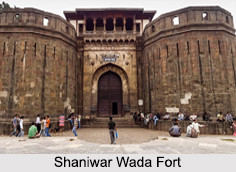 Shaniwar Wada
Shaniwar Wada
The seat of the Maratha Empire from 1713 to 1830, the Shaniwar Wada was built by the Peshwas of Chhatrapati. In the 18th century, the fort used to be a centre of Indian politics but now lies in complete ruins since it has nearly been destroyed by military attacks and majorly by an unexplained fire in 1828.



















